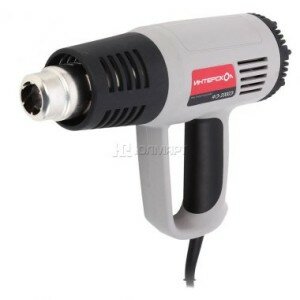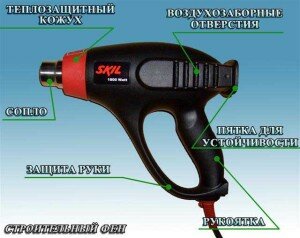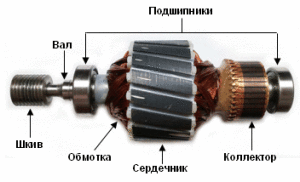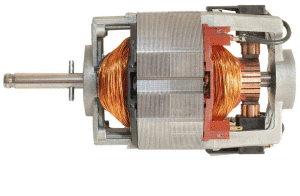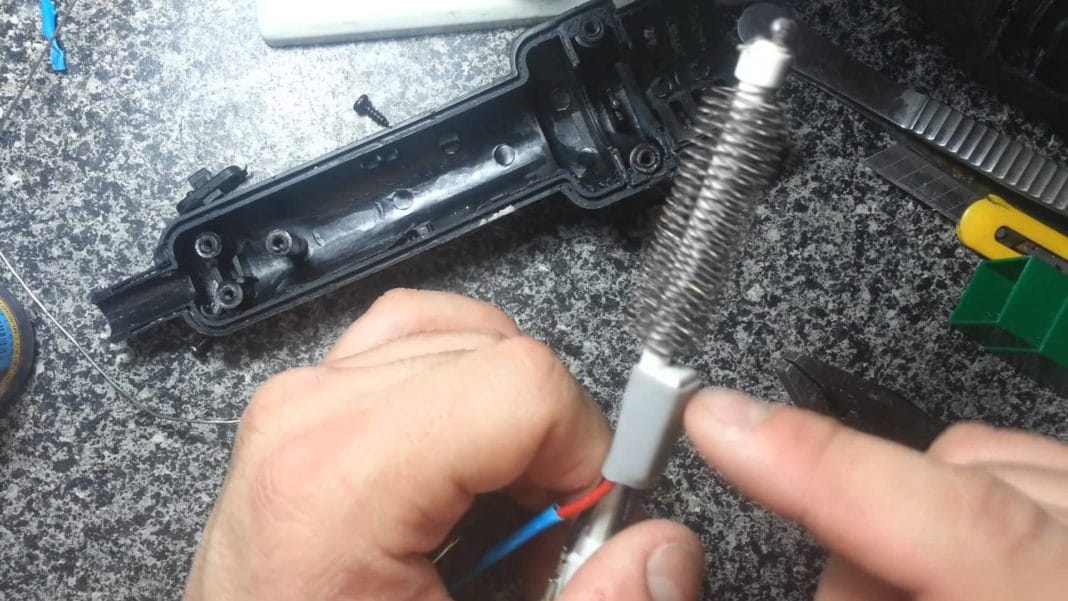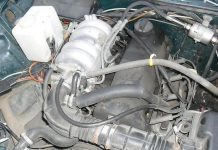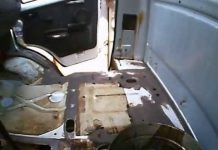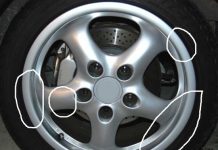In detail: DIY repair of a construction hair dryer from a real master for the site my.housecope.com.
We all are familiar with such an auxiliary tool in construction as a construction electric hair dryer, which we are used to using for removing paint and varnish coatings.
The basic principle of operation of a construction hair dryer is not much different from an ordinary hair dryer that we use to dry our hair.
Accordingly, the electrical circuit of a building hair dryer is similar to the electrical circuit of an ordinary hair dryer.
An explanation will be given in the stated topic:
- electrical diagram of a building hair dryer;
- the principle of the construction hair dryer;
- possible reasons for the malfunction;
- elimination of these malfunctions.
Consider the electrical circuit in Fig. 1 of the building hair dryer:
One diagonal of the diode bridge is connected to an external source of alternating voltage 220V.
The other diagonal of the diode bridge is connected to the electric motor.
The electrical diagram consists of the following elements:
- toggle switch performing the control temperature mode - K1;
- a toggle switch that controls the speed of the blowing speed of the electric motor rotor - K2;
- toggle switch for disconnecting heating elements - K3;
- fan motor - M;
- capacitor - C;
- Heating elements - RTEN;
- diodes - VD1, VD2.
Through the diode bridge circuit of one diagonal of the bridge, the rectified current of two potentials +, - is supplied to the electric motor. When passing from the anode to the cathode, the current flows with a positive half-cycle of the sinusoidal voltage.
Two capacitors connected in parallel in an electric circuit serve as additional smoothing filters.
The blowing speed occurs due to the variability of the resistance in the electrical circuit, that is, when the speed toggle switch is switched to the highest resistance value, the rotation speed of the electric motor rotor decreases due to the voltage drop.
| Video (click to play). |
The number of heating elements of heaters in this scheme is four. The temperature regime of the construction hair dryer is carried out by the temperature control toggle switch.
The heating elements in the electric circuit have different resistance, - accordingly, the heating temperature when switching from one section of the electrical circuit to another - heating the heating elements will correspond to its resistance value.
The general appearance of the construction hair dryer with its names of individual parts is shown in Fig. 2
The following electrical diagram of the building hair dryer in Fig. 3, is comparable to the electrical circuit in Fig. 1
There is no diode bridge in this wiring diagram. Blowing speed control and temperature control - occurs when switching from one section of the electrical circuit to another, namely:
- when switching to a section of an electrical circuit - consisting of a diode;
- when switching to a section of an electrical circuit that does not have a diode.
When a current flows in the anode-cathode junction of the VD1 diode, which has its own resistance, the heating element2 will heat up according to two resistance values:
- resistance at the transition anode - cathode diode VD1;
- resistance of heating element heating element 2.
When a current flows in the anode-cathode junction of the diode VD2, the voltage supplied to the electric motor and the heating element1 will take the lowest value.
Accordingly, the speed of rotation of the rotor of the electric motor and the heating temperature of the heating element for a given section of the electric circuit will correspond to the direct transition of the current of the diode VD2. Heating of the heating element heating element1 for a given section also depends on its internal resistance, that is, the resistance of the heating element is taken into account.
The main reasons for the malfunction of the construction hair dryer here can be called the malfunction of the electronic elements:
Most often, such a malfunction occurs with a sharp jump in an external source of alternating voltage. For example, the cause of a capacitor malfunction is caused by the fact that the capacitor plates are closed when there is a voltage jump between themselves - short-circuited.
Of course, such a possibility of a malfunction as a rupture in the stator winding of an electric motor, winding burnout, is not excluded.
Minor malfunctions include such reasons as:
- oxidation of the temperature control toggle switch contacts;
- oxidation of the contacts of the toggle switch for controlling the blowing speed;
- oxidation of the contacts of the toggle switch for disconnecting the heating elements;
- a wire break in a network cable;
- defective plug lack of contact.
Diagnostics to identify the cause of the malfunction is carried out by the "Multimeter" device.
When replacing a capacitor, its capacity and voltage rating are taken into account.
When replacing a diode, the resistance of two values is taken into account, in the directions:
- from anode to cathode;
- from the cathode to the anode.
As we know, the value of resistance from anode to cathode will be significantly less than from cathode to anode.
With an electric motor, if it malfunctions, things are more complicated. With such a malfunction, it is easier to replace the electric motor than it is permissible to rewind the stator windings. But even such work is doable - who is directly involved in such repairs. In this case, the following is taken into account:
- the number of turns in the stator winding;
- section of copper wire.
Such a malfunction as burnout of the heating element is not excluded. Replacing the heating element is carried out taking into account its resistance value.
Consider the device of electric motors and how exactly it is necessary to diagnose electrical machines, as they are usually considered in the section on electrical engineering.
For an illustrative example, photographs of several types of such electric machines are presented - related to collector motors. The device and principle of operation are admissible two collector electric motors:
- is no different. The difference in electric motors is only in the rotor speed and in the power of the electric motor. Therefore, we, as it were, will not sharpen our attention in the sense that explanations are given that are not related to the electric motor of the construction hair dryer.
The electric motor of the building hair dryer is asynchronous, collector, single-phase alternating current.
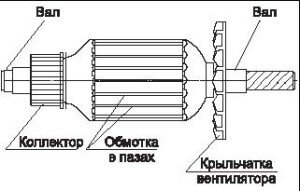
The rotor device does not require any explanation, since everything is shown in the photograph in Fig. 4 and a schematic representation of the electric motor rotor.
asynchronous collector motor single-phase alternating current
The electrical diagram of the collector motor in Fig. 5 is as follows:
In the circuit, we can notice that the collector motor can operate on both alternating and direct current - these are the laws of physics.
The two stator windings of the electric motor are connected in series. Two graphite brushes in contact - in electrical connection with the motor rotor collector.
The electrical circuit closes on the rotor windings, - accordingly, the rotor windings in the electrical circuit are connected in parallel through the brush-collector sliding contact.
diagnostics of stator windings of an electric motor
The photograph shows one of the methods for diagnosing the stator windings of an electric motor. In this way, the integrity or insulation breakdown of the stator windings is checked. That is, one probe of the device is connected to any of the brought out ends of the stator windings, the other probe of the device is connected to the stator core.
In the event that the insulation of the stator winding is broken and the winding wiring shorts to the core, the device will indicate a zero resistance value in the short circuit mode. It follows from this that the stator winding is defective.
The device in the photograph indicates a one when diagnosing - this does not mean that this stator winding is suitable for operation.
It is also necessary to measure the resistance of the windings themselves. Diagnostics is carried out in the same way, - the probes of the device are connected to the removed ends of the wires of the stator windings. With the integrity of the windings, the display of the device will indicate the resistance value possessed by this or that winding. If one or another stator winding breaks, the device will show "one". If the stator winding wires are short-circuited with each other as a result of overheating of the electric motor or for other other reasons, the device will indicate the lowest zero resistance value or "short circuit mode".
How to check the resistance of the rotor winding with a device? - To do this, you need to connect two test leads of the device to two opposite sides of the collector, that is, you need to make the same connection that graphite brushes have in electrical connection with the collector. The diagnostic results are reduced to the same indications as when diagnosing the stator windings.
What is a collector in general? - The collector is a hollow cylinder consisting of small copper plates of a special alloy, isolated from each other and from the rotor shaft.
In the event that the damage to the collector plates is insignificant, the collector plates are cleaned with fine-grained emery paper. Again, this amount of work can be performed directly only by specialists who repair electric motors.
The electrical circuit in Fig. 7 consists of a battery and a light bulb, this circuit is comparable to that of a pocket flashlight. One end of the negative potential wire is connected to the stator core, the other end of the positive potential wire connects to one of the brought out ends of the stator windings. If the wires are connected the other way around, that is, "plus" to the stator core, "minus" to the output end of the stator winding, nothing changes from this.
In the presence of insulation breakdown, when the stator winding is closed with the core, the light in this electrical circuit will be on. Accordingly, if the light does not light up, then the stator winding is not closed with the stator core.
This method of diagnosing Fig. 7 is not complete. Accurate diagnostics is carried out only with an Ohmmeter device or a Multimeter device with a set resistance measurement range, for subsequent measurement of the resistance of the stator windings.
During the repair and installation of various structures, a building hair dryer is used to warm up old paint and varnish coatings, which would otherwise be difficult to remove from the surface. It is also used in construction when soldering metal and when working with plastic pipes, which, when heated, can be given the desired bend shape. However, it should be borne in mind that a construction hair dryer is a complex device and, if used improperly, can receive serious damage, the elimination of which will require a waste of time and effort.
Performing equipment repairs yourself may become a necessity if the warranty period has already expired, or you cannot stop work while the device is at the service center. In such a situation, you need to know how to diagnose a breakdown and carry out repairs.
The main elements of any such device are:
- a heating element;
- small engine;
- fan.
The air is blown by the fan and passes through the heating element, acquiring the desired temperature, and exits through the nozzle. Such a device differs from the hair dryer with which we dry our hair, only in power, otherwise they work on a similar principle.To calculate the performance, an indicator of throughput is used: how many liters of air can pass through the equipment per minute.
Additional functionality provides convenience in work and at the same time complicates its design. These functions may include:
- heating level indicator light;
- the ability to adjust the temperature;
- the ability to adjust the strength of the air flow;
- replaceable attachments for working with various materials.
If you are dealing with a model, the functionality of which has been significantly expanded, then it makes sense to contact a repair specialist. Since the diagnosis and replacement of parts in this case may require special knowledge.
Experts call the following equipment breakdowns that occur most often:
- breakage of the power cord at the bend;
- defect of the start button and other control elements;
- burnout of internal wires;
- violation of the integrity of the heating element;
- burnout or overheating of the motor and fan.
The most difficult breakdowns are considered just a malfunction of the engine and fan - they will most likely have to be replaced. At the same time, finding the necessary parts can be quite difficult.
The hair dryer won't turn on or isn't working at full capacity? This means, first of all, it is necessary to inspect the equipment. We check the integrity of the power wire, plug, the operation of the power buttons and temperature control.
Next, we test the equipment when operating in various modes.
- If, when turned on, the device emits cold air from the nozzle, the malfunction concerns the spiral.
- If the air is not supplied at all, it is possible that the fan or motor has failed.
To clarify the cause of the breakdown, it may be necessary to disassemble the electrical appliance. Then you will need a camera: the frames of the stage-by-stage analysis of the structure will then help to correctly assemble the device.
You can start repairing the equipment as soon as diagnostics are carried out. For these purposes, you may need a screwdriver and a soldering iron, as well as parts that need to be replaced.
- Replacing the coil (heating element) usually does not cause any particular difficulties. In this case, the resistance value should be taken into account.
- Conductors that have come off can be secured to the desired location using a soldering iron.
- If it is necessary to replace the capacitor, then the selection of the desired part is based on the capacity and the nominal voltage value.
- The malfunction of the electric motor is mainly solved by replacing it, but it is not so easy to accomplish it.
To replace the external wire, you will also need to disassemble the device case and disconnect the damaged wire first. During work, try to put all the parts in one container so that nothing is lost. If you have any doubts about your own ability to carry out repairs, then it is better to entrust the restoration of the work of your construction hair dryer to the specialists of the service center.
With the help of a hair dryer, you can heat up old varnish or paint to remove them from the surface. During construction, it is used to solder metal, as well as to facilitate the handling of plastic pipes. In a heated state, they lend themselves well to bending. This tool is very whimsical, and in case of improper use it will have to be repaired, and this is not an easy task.
Consider how to repair a building hair dryer with your own hands. A person can always contact specialized service centers for such a service, but this is not always advisable. In some cases, breakdowns can be diagnosed independently, respectively, and the repair of the construction hair dryer itself can be done.Before that, it is imperative to get acquainted with the device device. This is where the instruction should begin.
Opening the device reveals a small motor, heating element and fan. The heated air exits through the nozzle. Everything is simple enough. Basically, the structure does not differ from an ordinary hair dryer. The only difference is the higher power of the device. The performance of the equipment directly depends on how many liters of air it can pass through itself in 1 minute. Many hair dryer models on the market today have a number of additional functions. These include:
Using a building hair dryer.
- temperature control;
- air flow regulation;
- selection of the required operating mode;
- numerous additional attachments that will significantly simplify the work with this or that material;
- LED indicator that determines the heating temperature.
Of course, these are not all the options that a building hair dryer can have. There are others. You should always remember that the more there are, the more difficult it is to make repairs.
Breakage of such a tool can occur at any time during its operation. It is especially unpleasant if this is in the midst of construction work. In most cases, the person himself is to blame, who is often negligent about the power tool. The main breakdowns are considered to be the bend of the power cord, a malfunction of the button for turning on the tool and adjusting the temperature. Of course, more global breakdowns can also occur.
Wiring diagram for a hair dryer.
For example, a motor or fan may be damaged. The heating element is not eternal in this respect. Most of the faults can be diagnosed on their own, but there are those that have to be identified for a long time. In this situation, it is best to contact a specialized service center.
If a person is confident in his abilities, then he can repair the hair dryer on his own.
The most difficult breakdowns include engine or fan breakdown. In most cases they need to be replaced and it is difficult to find the right spare parts.
Before proceeding with repair work, it is imperative to inspect the device.
Already at this moment, most of the troubles can be identified. Be sure to pay attention to the on and off buttons of the tool, as well as the state of the wiring. Perhaps the cord was just broken in some place or the plug was broken. All this can be determined already at the preliminary stage of work.

